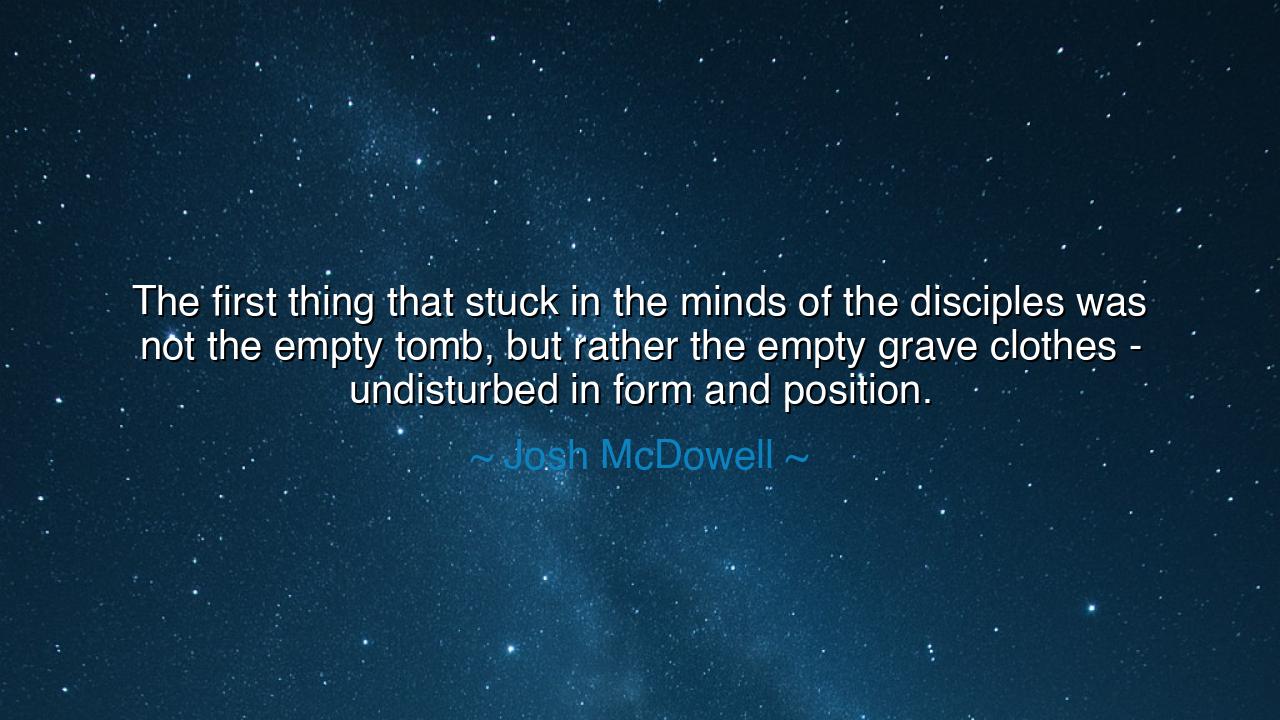
The first thing that stuck in the minds of the disciples was not
The first thing that stuck in the minds of the disciples was not the empty tomb, but rather the empty grave clothes - undisturbed in form and position.






The words of Josh McDowell — “The first thing that stuck in the minds of the disciples was not the empty tomb, but rather the empty grave clothes — undisturbed in form and position” — illuminate one of the most profound mysteries in human faith: the Resurrection not as spectacle, but as revelation. In this image of empty grave clothes, still folded and resting in the shape of the body that once lay there, we behold the quiet power of the divine — a power that moves not through thunder or flame, but through stillness and order. McDowell’s reflection leads us to a deeper truth: that what awakened the disciples’ faith was not the absence of Christ, but the calm testimony of His presence beyond death.
In the ancient world, when a body was prepared for burial, the wrappings were tightly bound with spices and linen, sealing the dead in a shroud of solemn care. To see those wrappings left untouched, as though the body had simply passed through them, was to behold something beyond natural explanation. The empty tomb could have been stolen or tampered with, but the undisturbed grave clothes bore the mark of the impossible — that life had transcended decay without disturbance, that spirit had triumphed over flesh. The disciples did not find chaos or disorder; they found peace, a divine stillness that whispered of eternity.
This moment, simple yet sublime, reflects an eternal law of the spirit: that the greatest transformations happen not with noise, but with graceful silence. When the disciples saw the empty wrappings, they understood that the power of God works in perfect order. It does not break the world’s harmony — it fulfills it. The grave clothes remained like the chrysalis after the butterfly has flown, a silent testament to resurrection, to the idea that what is truly alive cannot be confined by the bonds of the earth.
Consider the story of Thomas, who doubted until he could touch the wounds of Christ. Yet even before Thomas’s faith was restored, others had already believed — not through touch, but through seeing the stillness of the linens, the absence of disturbance. They believed because truth leaves no trace of struggle, only clarity. McDowell’s words remind us that sometimes faith does not come from witnessing the miracle itself, but from perceiving the signs it leaves behind — the quiet, unbroken patterns that tell of divine intention.
This truth is reflected throughout history. When Florence Nightingale walked through the dark wards of Crimea, she did not shout of miracles or visions. She simply left order, cleanliness, and care in her wake. And when others entered, they saw — in the undisturbed form of her work — that compassion had already passed through. Like the empty grave clothes, her legacy spoke of transformation beyond words. True resurrection — whether of the soul, of nations, or of faith — often reveals itself in the quiet traces left by those who have risen from despair into purpose.
McDowell’s reflection also serves as a lesson against the modern temptation to seek faith in spectacle. Many look for signs and wonders — for lightning and glory — yet miss the deeper proof that lies in stillness and order. The disciples did not see the moment Christ rose; they saw the evidence of peace left behind. And in that peace, they recognized eternity. Faith, then, is not the grasping after visions, but the recognition of divine presence in the calm, the quiet, the undisturbed.
The lesson is clear: do not wait for the heavens to shake before you believe that resurrection is possible. Look for the small, undisturbed signs of grace in your own life — the peace after pain, the light that lingers after loss, the quiet strength that remains when the storm is over. These are your empty grave clothes, your proofs that life continues, that renewal is real.
Therefore, let us live as those who have seen the tomb and understood the meaning of the folded linen — that death, defeat, and despair are not the final word. In the stillness where all seems lost, the eternal moves unseen. The divine does not announce its triumph with noise, but leaves behind order, beauty, and calm — proof that the soul has risen. To mark these signs is to believe, and to believe is to rise ourselves, every day, from the grave of fear into the light of everlasting hope.






AAdministratorAdministrator
Welcome, honored guests. Please leave a comment, we will respond soon